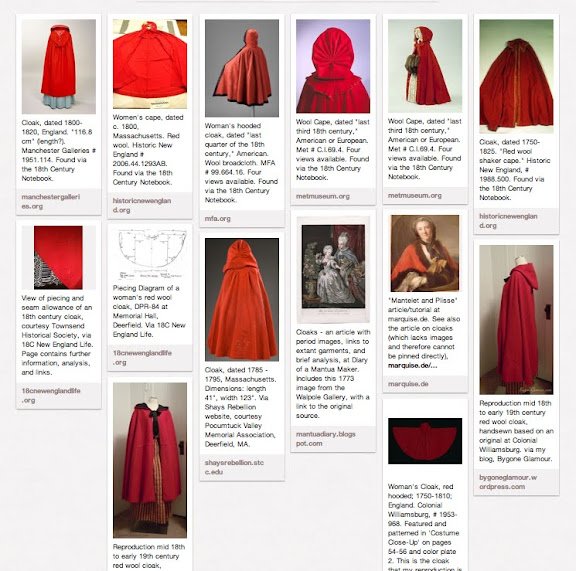I like to describe Pinterest as “the great cork board in the sky.” I started out using it the way many people do, as a virtual idea board – an easy way to collect images and ideas for fashion I like, sewing tutorials I find interesting, home decorating ideas, and recipes. I installed the Pinmarklet to my bookmarks bar and pinned cute sweaters and tasty treats as I prowled the blogosphere. Before long, I also started pinning images of historical costumes, and I realized that Pinterest offered a brilliant way to collect research images, allowing me to peruse them visually, while organizing them by period and theme – while maintaining a perpetual link back to the original source. It doesn’t matter how many times something gets re-pinned – it will always link back to its original web source.
This is why I get cranky when people say that Pinterest is just the new Tumblr. At the risk of offending, I must say that I absolutely loathe Tumblr. There’s some good stuff on Tumblr blogs sometimes, but there’s a whole lot of plagiarism, copyright infringement, and images that don’t lead back to the original source. I keep encountering this aggravating phenomenon as I go to re-pin a lovely extant dress… and discover that it comes from a pretty-pretty-stuff Tumblr, with no source information to be found. What museum collection is the dress in? When is it from? Are there alternate views or further information somewhere? I hate not knowing these things. So I often either skip the image, or spend a bit of time tracking down the original source. An image without a proper source link isn’t very useful, or very respectful to the museum that owns both the garment and the copyright on the photograph.

My Pinterest Board for Mid 19th Century Skirt Supports
But with properly sourced images and all the relevant details in the text blurb, Pinterest makes for an outstanding historical costume research tool. You can pin by period, and then break it down into specific garment types or even projects you’re working on. You can look at a collection of themed images together, and you can also click through to the original source to get more information. While the copyright legalities of Pinterest haven’t yet been hashed out, it seems like an excellent example of fair use, one that gives full credit (and free advertising!) to the museums, auction sites, and private collections that own the beautiful clothes we’re interested in researching. I don’t like to save online images on my computer for research use, because no matter how long I make the file name, I’ll always be lacking some information, and it will always be a multi-step process to get from the image on my computer back to the webpage where I found it.
Since Pinterest can be such a fantastic tool for historical costume research, and I’ve spent a lot of time thinking about the logistics of how to best use it for that purpose, I thought I’d write up a how-to of sorts. This is what works for me, and perhaps it will work for others as well.

Some of My Historical Costume Boards
The historical costume section of my Pinterest is primarily organized chronologically by period. First, I have some general history-of-costume boards (e.g., historical stitching details, historical textiles), then it’s on to Costume: 16th Century, Costume: 17th Century, Costume: 18th Century, and then 19th Century Quilted Petticoats. Wait, what? I do more with 19th century costume than with earlier periods, so it makes sense for me to subdivide the century into shorter periods. But quilted petticoats cross multiple periods, and I’m interested in them over multiple periods, so I gave them their own, broader board. Next up we get into specific periods – Regency, Early Romantic Era, and then a number of 1830s-specific boards. Again, this reflects the focus of what I study. There are more boards, and more specificity, to subjects I’m doing more research for. In general, when I find that a particular board is broad in subject matter and has more than a hundred pins, I start sub-dividing. I like being able to find what I’m looking for!

This results in a lot of pin-boards. I wish Pinterest allowed for nesting of boards! It would be nice to be able to have, for example, a “Romantic Era” category, that within it had all my various subdivisions by decade and garment type and project. But I keep my many boards fairly well under control by keeping them carefully organized in a way that makes sense to me, and naming the boards so that I can find what I’m looking for as easily as possible while pinning. All of my major historical eras start with a heading of “Costume,” so they’re all together when I go to pin. The specific eras I’m working on, which are subdivided into many boards, start with a heading that’s time-specific: 1830s, 1912 Project, and Mid 19C (for mid 19th century). If your costuming interests are less broad than mine, this part of the organizing process will be simpler for you.
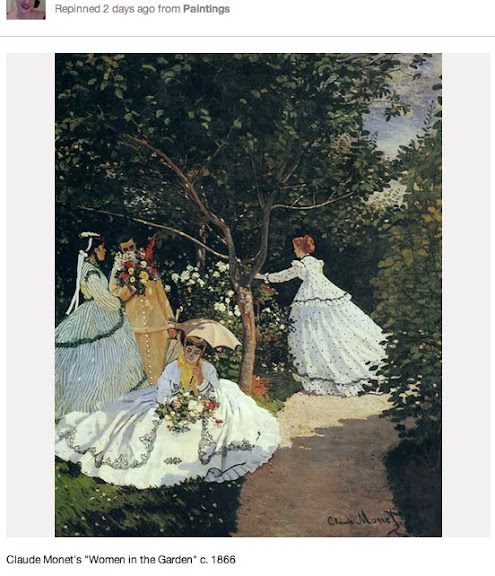
Re-Pinned Painting With a Dead Source Trail
Beware when re-pinning pretties – the images can be from anywhere, and for the sake of responsible pinning and useful research, it’s important to try to pin images from something resembling the original source. I love the dresses in Monet’s “Women in the Garden,” so when the above image turned up in my feed, I promptly re-pinned it to my “Costume: Transitional Bustle” board. But when I clicked through, wondering what museum actually owns this beautiful painting, I found that it had been pinned from a vintage clothing shop blog that used museum images, didn’t link back to the image sources, didn’t even mention what museums the images came from, and did this with posed photographs of extant costumes as well as with images of two-dimensional works of art.
That’s not just rude, it’s illegal. The above painting is in the public domain, so that means that “slavish recreation” is likewise in the public domain. But no matter how old a costume is, it’s three-dimensional, so when a photograph is taken of it, the photographer – or, more likely, the museum who hired the photographer – owns the copyright on that photograph. Given that this particular blog was a commercial site for a shop, this makes the copyright infringement even more egregious. I don’t want to have anything to do with a site that’s infringing on copyright and not even attempting to give the source credit. So I copied the url for the picture, popped it into Google image search, and went looking for another place to get a copy of “Women in the Garden.?
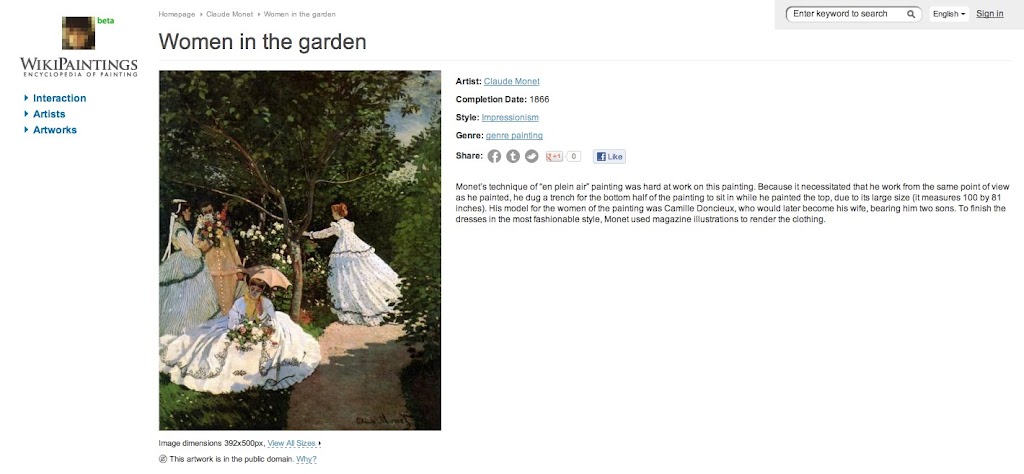
Monet's "Women in the Garden" on WikiPaintings
I found it on WikiPaintings, which also informed me that the painting is in the public domain, because the artist died over 70 years ago. Museums tend to disagree with this interpretation of copyright law, but the courts consistently uphold it. (For more information, see my page on Copyright Issues.) Ideally, this page would also mention which museum currently holds the painting, but given the public domain status, I can let it slide. So I set about pinning this copy of the painting.

I entered the vital statistics, including style and genre information, into the text box, and selected the category “Mid 19th Century Genre Paintings and Portraits” to pin it to.

Then I added the detail that it was public domain – which I think is handy to know when I’m glancing through my pins – and added where I’d pulled the image from. If I were pinning from a museum, I’d also include the accession number, which is especially important to have since museums are continually changing their websites, and at some point the link to the original source could go dead. If that happens, I want it to be as easy as possible to find the painting, or dress, or pair of shoes that I’m looking for.

Now that I have all my details entered and my pin pinned, I can click “see my pin” and this is what I get. I also want to save this pin to my public domain costume images board, and to my transitional bustle era costume board, so I re-pin it to both, using the same text blurb.
But what about pinning directly from a museum? What about all of the bits and pieces to copy-paste? Does it really matter if it’s properly formatted and everything is right there? I certainly think so! I want all of the relevant details right there where I can see them, and I want to know what else there is on the museum website. So I have a particular system for pinning from museum websites, and it’s not nearly as time-consuming as you might think. I’ll show you my process with an example from a couple days ago.
My Reproduction Red Wool Cloak
Last year, I made a reproduction red wool cloak based very closely on the original depicted in Costume Close-Up. While I was working on it, and while I was writing up the documentation afterward, I bookmarked quite a few links to extant cloaks, articles about cloaks, and general information. A year later, only about half of those links still work. Sites have shut down or reorganized, museums have changed their online catalogs, and so forth.
But the other day when I went to make a Pinterest documentation board for my red wool cloak, I tracked things down again, and found more sources by way of a great article on the 18th Century Notebook – which I couldn’t pin directly, because it didn’t have any pictures, but which I gave credit to in my pins, because curating the internet is hard work, and the site deserves recognition.

First things first, I created a new Pinterest board, specifically for this project/garment. Then I opened in tabs all of my cloak-related bookmarks, and my documentation post, which I knew had links to relevant things.
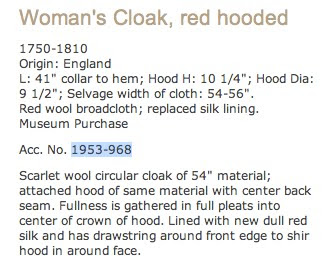
I started with the cloak in the Colonial Williambsurg collection that appears in Costume Close-Up, because it’s the one that mine is directly based on. I can’t show you the whole website, or a picture of this original cloak, because the image is copyrighted by Colonial Williamsburg, and I’d rather not infringe on that (which is why I’ve blurred out the thumbnail of the cloak in the pinning pictures below). When pinning an object from a museum collection, the first thing I do is highlight and copy the accession number, as you can see in the screen capture above-left.
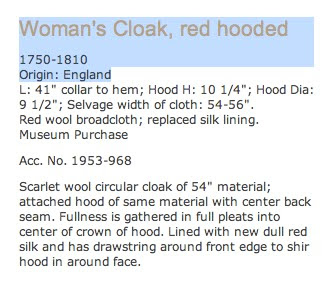
Next, if the format of the page will cooperate, I highlight the item name or title, the date, and the place of origin. (Sometimes, I highlight other details along with these.) Highlight the text, but don’t copy it – when you click the “pin it” button, the Pinmarklet will automatically insert the highlighted text.
When the pinning box first opens, the copied text is weirdly formatted, and sometimes suffers from OBNOXIOUS ALL CAPS and too many spaces. This drives me crazy, so I spend a few extra seconds fixing it.

Pins don’t have new-lines or paragraphs, so those will just turn into spaces. Double spaces. Yuck. I delete the new-lines and I format the text like this: “(Object), dated xxxx, (location of origin). (Museum) # xxxxxxxx.” Make sure to put a space between the # and the accession number, or Pinterest will treat it like a hash tag. If I’m including dimensions or other basic stats, I sometimes include those between the location the the museum information. If I’m quoting description from the museum, I put it in quotation marks (because that, my friends, is how we avoid plagiarism!), and if I’m adding comments of my own, I put them last.

For this pin, I swapped out the commas for semi-colons, to avoid confusion with the object’s name, which includes a comma. And I seem to have put a comma after the museum name. I do that sometimes. I never claimed to be perfectly consistent, now did I? Anyway – this copying and then highlighting approach means that I don’t have to type up much of the text in my blurb. I just reformat and add the museum name, plus whatever comments I might have, such as what page of a given book the object is featured on. For this pin, the text ended up reading:
Woman’s Cloak, red hooded; 1750-1810; England. Colonial Williamsburg, # 1953-968. Featured and patterned in ‘Costume Close-Up’ on pages 54-56 and color plate 2. This is the cloak that my reproduction is directly based on.
But what about pinning from a blog? And what about reproductions? Whenever I pin a reproduction, I write “Reproduction” (or “repro”) at the very beginning of the pin, to make it very clear that this isn’t an original. I also make sure to include the name of the blog it came from – because the person who made that garment deserves full credit.

Here we have a screencap from this very blog, taken as I pinned my reproduction cloak, the way I pin any repro from a blog. I highlighted the name of the garment/post, and then clicked “pin it.” When I reformat that text in the Pinmarklet, I add “reproduction” to the beginning, and include any other relevant details. Then I credit the blog, like so: “via Bygone Glamour.”
Voila!
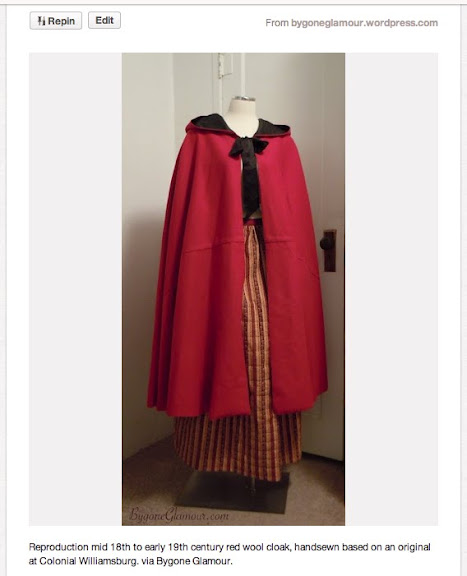
The pin text for the cloak image now reads “Reproduction mid 18th to early 19th century red wool cloak, handsewn based on an original at Colonial Williamsburg. via Bygone Glamour.” Except that’s kind of awkward, because it’s my own blog – so after I took this demo screencap, I changed the text to read “via my blog, Bygone Glamour” at the end. When I pinned the second image, the side view, I simply copied and re-used the same text.
After prowling through cloak links and doing some pinning, this is what my new board looked like:
(There are copyright images included in the above, but they are teeny tiny, and essentially incidental, so they ought to fall under the heading of fair use.)
Pinterest is a wonderful tool for historical costume research, but to make full use of it, we have to be careful to include all the important details, especially the name of the museum or auction house or blog and the accession number or lot number if there is one. That number is a lifeline – it’s how you track down your favorite dress at the MFA or the Met or any other museum site after they change their website design and all of their collections links go dead. Thanks to the Google Images search function that allows you to search for an image based on the copied url of an image, it’s easier to track down lost museum objects, but let’s make it easier for ourselves and just include those accession numbers.
Now, what do you think? Is Pinterest useful for researching historical costume, or do you think it’s more like Tumblr – just another copyright infringement? How do you feel about re-pinning images that aren’t pinned from the original source? How has Pinterest helped your research?
p.s. if anyone is desirous of a Pinterest invite, let me know. I’m happy to share the pinning love!

